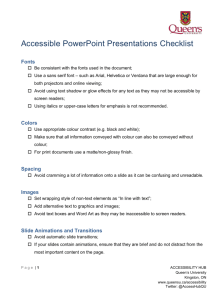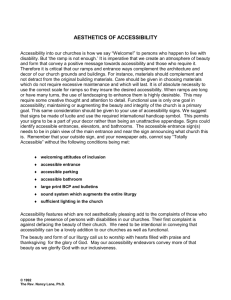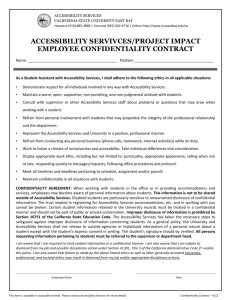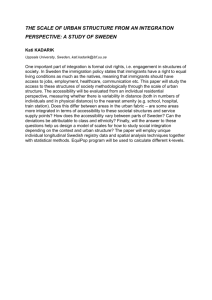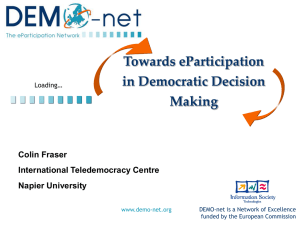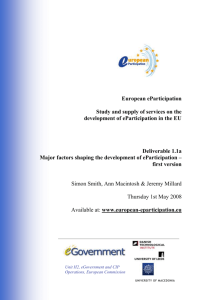Project benefits - WINEME BSCW Shared Workspace Server
advertisement
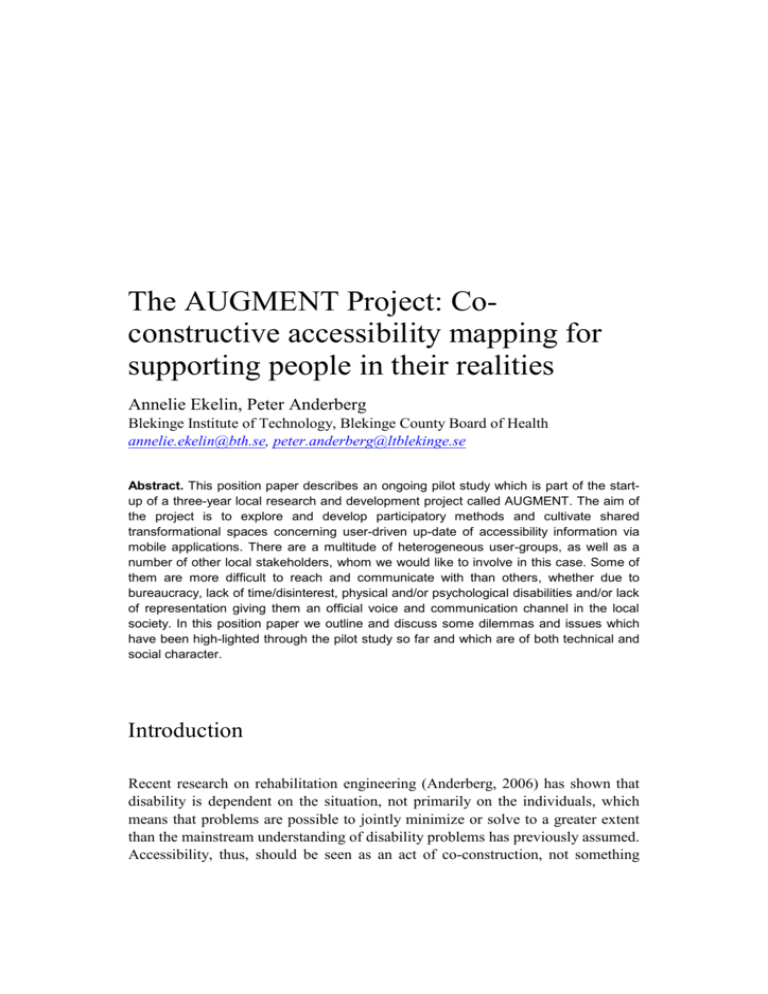
The AUGMENT Project: Coconstructive accessibility mapping for supporting people in their realities Annelie Ekelin, Peter Anderberg Blekinge Institute of Technology, Blekinge County Board of Health annelie.ekelin@bth.se, peter.anderberg@ltblekinge.se Abstract. This position paper describes an ongoing pilot study which is part of the startup of a three-year local research and development project called AUGMENT. The aim of the project is to explore and develop participatory methods and cultivate shared transformational spaces concerning user-driven up-date of accessibility information via mobile applications. There are a multitude of heterogeneous user-groups, as well as a number of other local stakeholders, whom we would like to involve in this case. Some of them are more difficult to reach and communicate with than others, whether due to bureaucracy, lack of time/disinterest, physical and/or psychological disabilities and/or lack of representation giving them an official voice and communication channel in the local society. In this position paper we outline and discuss some dilemmas and issues which have been high-lighted through the pilot study so far and which are of both technical and social character. Introduction Recent research on rehabilitation engineering (Anderberg, 2006) has shown that disability is dependent on the situation, not primarily on the individuals, which means that problems are possible to jointly minimize or solve to a greater extent than the mainstream understanding of disability problems has previously assumed. Accessibility, thus, should be seen as an act of co-construction, not something which someone has to provide for someone else. Accessibility information needs to be re-formulated and customized, depending on the individual’s circumstances and current location in space and time, rather than simply and statically presented as one-size-fits-all and relying on individuals learning generalized strategies of how to use “off-the shelf information”. New solutions providing access for disabled groups are frequently developed - this is not an issue any longer- the issue is rather: how are these new solutions communicated to those who need the information and in which way are they contributing to the understanding of accessibility? How can shared spaces be opened and cultivated for co-construction of accessibility? The AUGMENT project aims to work with groups and individuals who have experience of accessibility problem and who are not satisfied with current accessibility solutions, which have primarily concentrated on regarding accessibility as a reificated artifact (Ekelin, 2007) rather than a situation which is dependent on re-interpretation. The organization of physical places affects disabled people’s possibilities of participation. The physical environment in Sweden to some extent lacks relevant customization and there are also gaps in accessibility for groups of people with various disability problems. But the picture is not one-sided. In relation to rebuilding of physical environment, a number of accessibility problems are solved over time. The issue is rather how these changes and reinforcements are communicated to the affected groups and individuals who are dependent of such information. A repeatedly formulated wish from representatives of these groups is the possibility to describe environments with the help of images and other examples of ”rich pictures”, where the user her/himself can decide about and evaluate the offered accessibility. In a recent charting of different EU-initiatives, HANDISAM, the Swedish Agency for Disability Policy Coordination, point out that the aim of steering development and research towards more inclusive projects and solutions is based on the i2010 strategy which is the guiding framework for accessibility issues. There are ongoing discussions about legislation of eAccessibility within EU and the European Commission highlights the importance of prioritizing a coherent, mutual and effective strategy for eAccessibility, or web accessibility, in order to boost the development of the eSociety in line with a new social agenda. (KOM2008: 412, cited in Axelson, 2009, p.12) This is not, however, the main priority today. There is also great demand for flexibility and mobility, and a new generation of mobile web tools has been developed, contributing to supporting and enhancing this mobility and flexibility. Interactive features make it possible for individuals to contribute on various levels by posting experience based information on the web site. The figurative expression of “lowering the tresholds” has thus taken on a new meaning, beyond, yet based on, reflecting back to and further enriching, as it were, the original metaphor. Providing accessibility is not simply about providing information, but also about providing means of co-construction of the expressions of accessibility as well as form and content – providing space for exploring a multitude of experiences of variations of disability in relation to accessibility issues. Some interesting research issues in the AUGMENT project, as we see them evolving now, through our experiences within the on-going pilot project, are: In what ways will development towards more specific demands of flexibility and mobility and in design of place-based accessibility information reconfigure the notion of accessibility along with the experience of accessibility hindrances? What are the consequences for the design and management of a specific accessibility application? How might a WIKI1 solution based on cooperative reworking of material support participation by users? Could it support increased participation? Might it become a hindrance for some while supporting others? How could such problems be addressed in design and management of the application, if so? How can future navigation tools deliberately be designed for and make direct use of user generated content? What are the main issues concerning accountability and transparency which need to be addressed in design and management of such tools? Research approach and methods The researchers who are involved in the AUGMENT project come from various academic backgrounds, combining perspectives from Human Work Science, Informatics, Interaction Design and Rehabilitation Engineering. This has motivated a multi- and interdisciplinary approach in the project. The researchers have all, however, in one way or another, been working within the field of participatory design, eInclusion and eDemocracy for more than 10 years, which gives them, in some sense, a common ground and shared vision within the project. Recent R&D involvement which has inspired the AUGMENT project was our participation in The Planning Portal, a 3-year (2006-2009) national project coordinated by The Swedish National board of Housing and Planning. This was a project which had the aim of developing integrated map-based planning services 1 A WIKI (from the Hawaiian word wikiwiki, which means quick, fast) is a shared web site for cooperative reworking of versions and cooperative responsibility for content information. for supporting national, regional and local planning authorities, but also for promoting enhanced public map-based e-services to citizens. Another source of inspiration was the charting of on-going practices of eParticipation on a national and international level which Ekelin was commissioned to carry out for the Swedish Government (2008). Ekelin was also appointed “teamleader” in a national consultation about future e-democracy policy by the Swedish Government during 2009. Anderberg has a Ph D in Rehabilitation Engineering and has developed a model called FACE which discusses disability as a situation dependent attribute rather than depending on the individual. The research approach we have chosen concentrates on case studies, small-scale action-oriented R&D projects with a base in using qualitative ethnographic studies coupled with engineering development work. The basis for this approach is the Scandinavian tradition of workplace democracy with a deliberate use of multiple perspectives through iterative negotiation processes in ICT development. The aim is also to achieve conceptualization based on the interplay of practice and theory with a focus on participatory design processes. Project description The aim of this project is to develop public digital spaces, processes and infrastructure for user-driven co-construction of accessibility information, making use of existing handheld mobile phones which offer the possibility to upload pictures and comments via an application with a map-based interface such as that provided by Google Earth. The local development consists of constructing a suitable interface, a customer-generated database, and a wiki-solution for handling and maintaining data. The task is mainly charting of “unaccessible” places and the aim here is working with various groups of users and cases, for instance hospitals, public places, and common recreation places. The main issue here is to offer possibilities for direct participation by those affected. There is also a sister project running in Tamil Nadu, India called The Walk-on-Water project (Eriksén & Ekelin, 2008; Eriksén et al, in press), which has a different focus, but which we are using for trans-cultural comparison of evolving practices of user-driven and participatory design of public e-services based on co-construction among multiple local stakeholders of databases containing current, meaningful local information. In order to be able to concentrate on design of an easy-to-use solution with the user as co-constructer, the development process in the pilot project is focused on a specific modification (or module) of an existing and established application. The maintenance issue of the shared database is both a key to success and a serious challenge. An example of a basic solution is Google maps Street View (http://maps.google.com/) where you can walk around on the streets virtually and examine pictures and surroundings by assessing information on the map. In real life, use of GPS-based technology with positioning makes it possible to contribute to the map content with personal photos and comments. The locally developed interface contains a set-up of a user-driven accessibility database combined with a wiki solution in order to handle different versions of information (the information could be exemplified by scaling, individual evaluations, location of for instance toilets and so on). The aim of the project is to find new methods for continuous up-dating and ways to secure accurate, up-dated and high quality of status of accessibility in the local area. Project benefits The project benefits for the involved group of stakeholders are primarily practical: to jointly develop new ways of working around provision of accessibility information. It is also a way to gain goodwill for local authorities by the introduction of a customer-driven accessibility database which makes use of the implementation of a Wiki-solution in order to handle information. This is in line with recent development of new methods for accessible update of information and visions of creating good governance as well as shared responsibility for the quality of accessibility information. For the region, the suggested project is a way to offer improved accessibility for citizens at the same time as the affected groups are given a possibility of greater influence on the content of accessibility data as well as the presentation form and management of the data. On the political level, the issue of inclusion of all citizens is crucial, and the establishment of more well informed and democratic decision-making concerning accessibility issues is in line with visions of good governance. For the involved researchers, the project is expected to contribute to the development of more inclusive methods for participation, and a re-conceptualization of notions of accessibility and disability, as well as providing material for development of a new agenda for the Scandinavian approach to systems design with an even broader scope of direct participation than previously. We are also exploring differences between the related research traditions of end-user innovation and participatory design, and what we can learn from these differences, concerning how to provide useful feedback efficiently and effectively to software providers, software engineers and interaction designers, and thus support the development of sustainable infrastructures for inclusive design-in-use (Dittrich et al, 2002; Dittrich et al, 2009). . Issues to discuss further Identified critical issues which are suitable for further discussion are listed below: The possibilities/problems of shared database maintenance The issue of maintaining a culture of engagement/participation beyond the use of rational solutions based on the rationale of CRM The issue of accurate, valid and usable information seen as a basis for local continuous negotiations rather than the basic outcome References Anderberg, P. (2006) FACE- Disabled people, Technology and Internet. Doctoral dissertation. Available online at: http://www.certec.lth.se/doc/face/ . Anderberg P, Olander E, Jönsson B. and Sperling L, (2007). Enabling design. Invited paper in Kumar, S (Ed.) Rehabilitation Ergonomics. CRC Press, Taylor and Francis Group Anderberg, P., Flodin, E., Jönsson, B., Malmborg, L., Nordgren, C. and Svensk, A. (2005) Ethics in the making. Design Philosophy Papers, no 4, 2005 Axelson, von H. Kartläggning över initiativ för eInkludering i EU och Sverige. Delrapport: Regeringsuppdrag N2008/5985/ITP Bjerknes, G and Bratteteig, T . 1995. ‘User participation and democracy: A discussion of Scandinavian research on system development”, Scandinavian Journal of Information Systems Vol. 7, No. 1: 73-98. Blomberg, J., Giacomi, J., Mosher, A. and Swenton-Wall, P. 1993. ‘Ethnographic Field Methods and Their Relation toDesign’. In Participatory Design: Perspectives on Systems Design. D. Schuler & A. Namioka (eds.) Hillsdale NJ: Lawrence Erlbaum Blomberg, J, Burrell M and Guest, 2002. ‘An Ethnographic Approach to Design,’ in Handbook of Human-Computer Interaction in Interactive Systems. Jacko, J. and A. Sears (eds.), Lawrence Erlbaum Associates,Inc., New Jersey Dittrich, Y., Eriksén, S. and Hansson, C. (2002), PD in the Wild; Evolving Practices of Design in Use. In Binder, T., Gregory, J. and Wagner, I. (eds.), PDC 2002 Proceedings of the Participatory Design Conference, Malmö, Sweden, June 2002, pp.124-134. Dittrich, Y, Ekelin, A, Elovaara, P, Eriksén, S and Hansson, C., 2003. ‘Making e-government happen: Everyday co-development of services, citizenship and technology’, in Sprague, R H Jr. (ed.), Proceedings of the 36th annual Hawaii International Conference on System Sciences [HICSS’36], 6-9 January 2003, Big Island, Hawaii. Los Alamitos, California, & Washington, Brussels, Tokyo: IEEE Computer Society Dittrich, Y., Eriksén, S. and Wessels, B. (2009), From Knowledge Transfer to Situated Innovation: Cultivating spaces for co-operation in innovation and design between academics, user-groups and ICT providers. Blekinge Institute of Technology Research Report 2009:01. Ehn, P. 1993. ‘Scandinavian design: On participation and skill’. In Schuler & Namioka, (eds.) Participatory design, Principles and Practices. Participatory Design: Perspectives on Systems Design. Hillsdale NJ, Lawrence Erlbaum Ekelin, A. (2007): The Work to Make eParticipation Work, Dissertation No. 2007:11, Blekinge Institute of Technology Ekelin, A. (2007b) Situating eParticipation. In Understanding eParticipation. Contemporary PhD eParticipation Research in Europe. [eds. Avdic, A ; Hedström, K ; Rose, J ; Grönlund, Å. Örebro: Örebro University, Department of Business, Economics, Statistics and Informatics Eriksén, S. (2002), Designing for Accountability. In Berthelsen, O., Bødker, S. and Kuutti, K. (eds.), NordiCHI 2002 Proceedings of the Second Nordic Conference on Human-Computer Interaction, Tradition and Transcendence, Oct. 19-23, 2002, Århus, Denmark (pp.177-86). Eriksén, S., Kawlra, A., Jhunjhunwala, A. and Ekelin, A. (in press), Planning beyond the UrbanRural Divide: Participatory design of ICT for sustainable development in India and Sweden. Chapter in Bengs, C. [ed.], INSTEC book to be published autumn 2009. Eriksén, S. and Ekelin, A. (2008), Beyond the Buzz: Participatory, sustainable, convergent and high quality public e-services - developing methods and practices in India and Sweden. In Proceedings of the 31st Information Systems Research Seminar in Scandinavia IRIS 2008 Macintosh, A. 2006. eParticipation in Policy-Making: The research and the challenges, in Cunningham, P &Cunningham, M. (eds.) Exploiting the Knowledge Economy: Issues, Applications and Case Studies. IOS press, 364-369. Suchman, L, 1994. ‘Working relations of Technology Production and Use,’ Computer Supported Cooperative Work (CSCW). Vol. 2, pp. 21-39, Kluwer Academic Publishers, Netherlands.




